
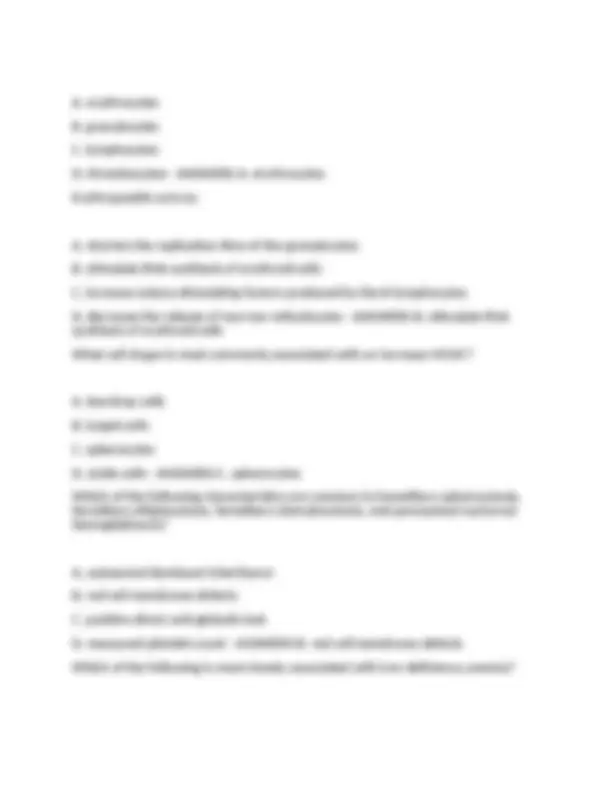
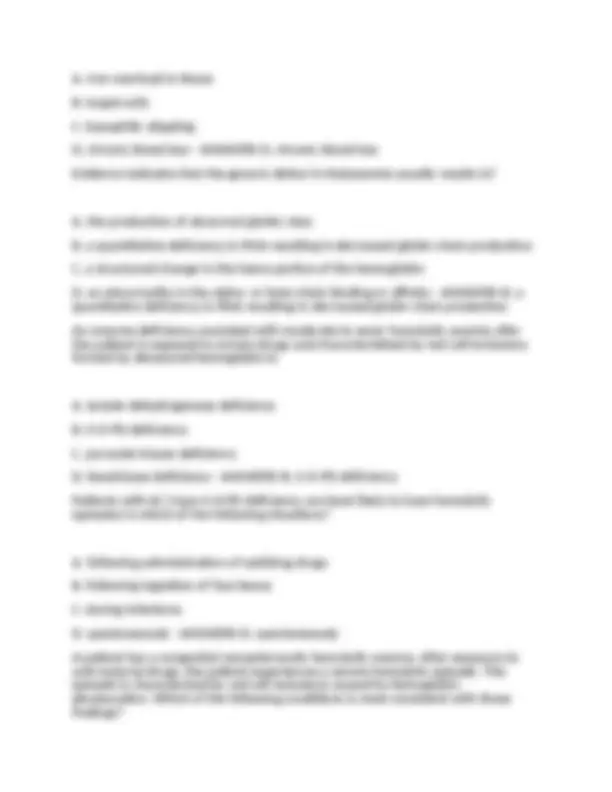
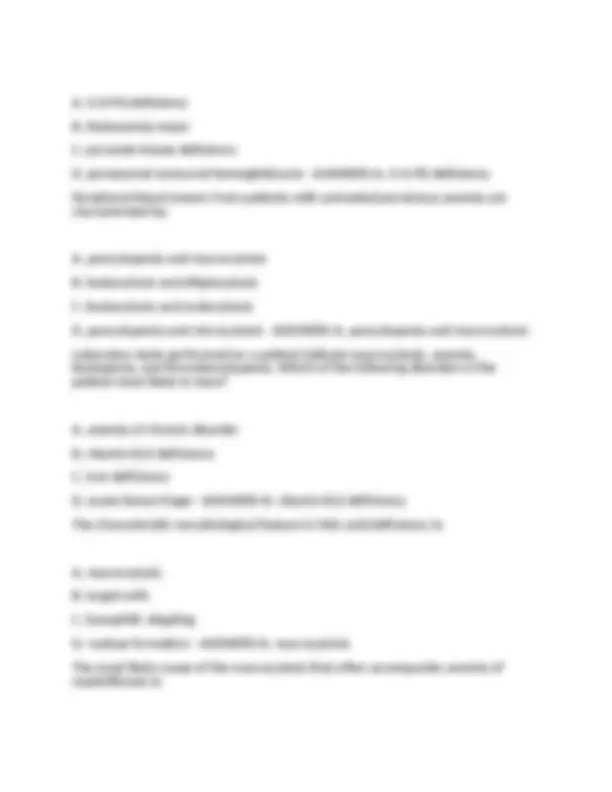

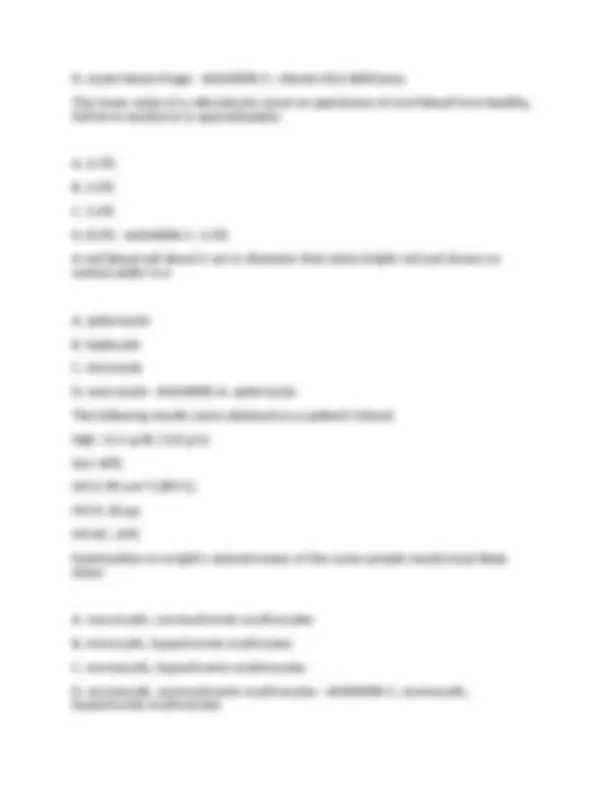
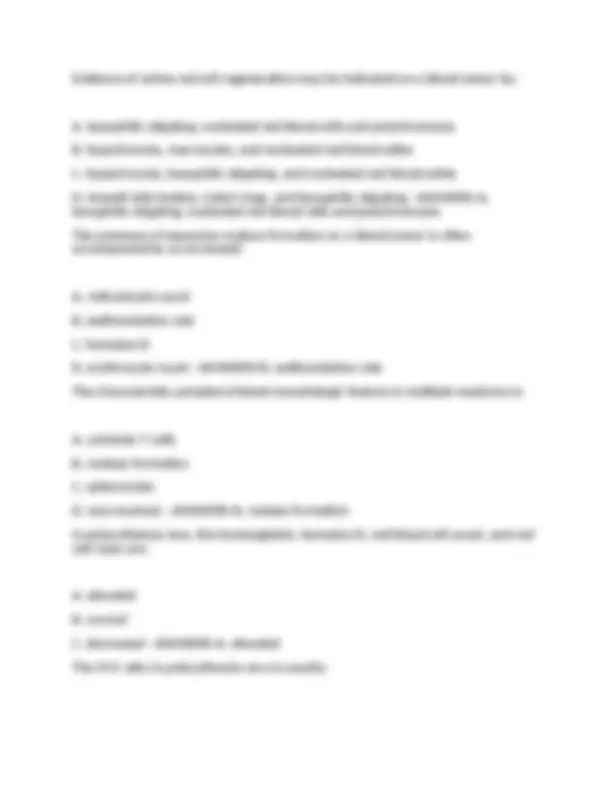
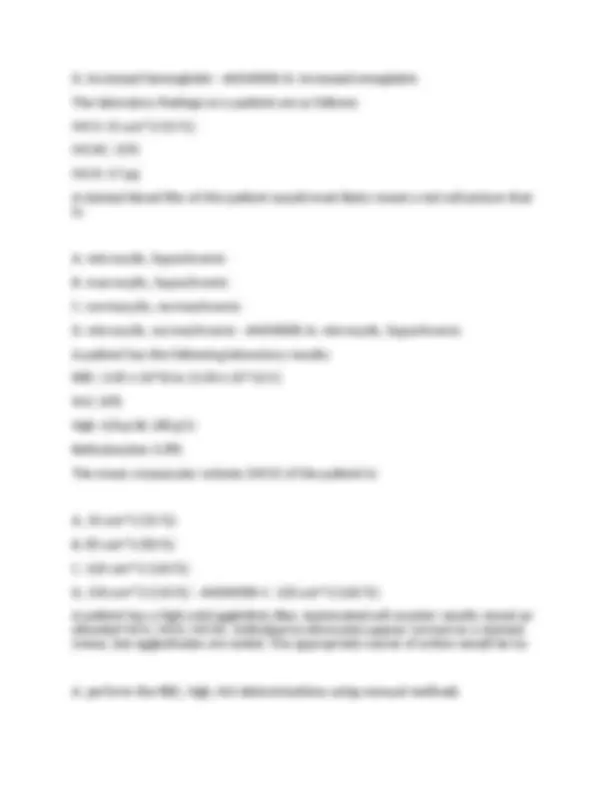
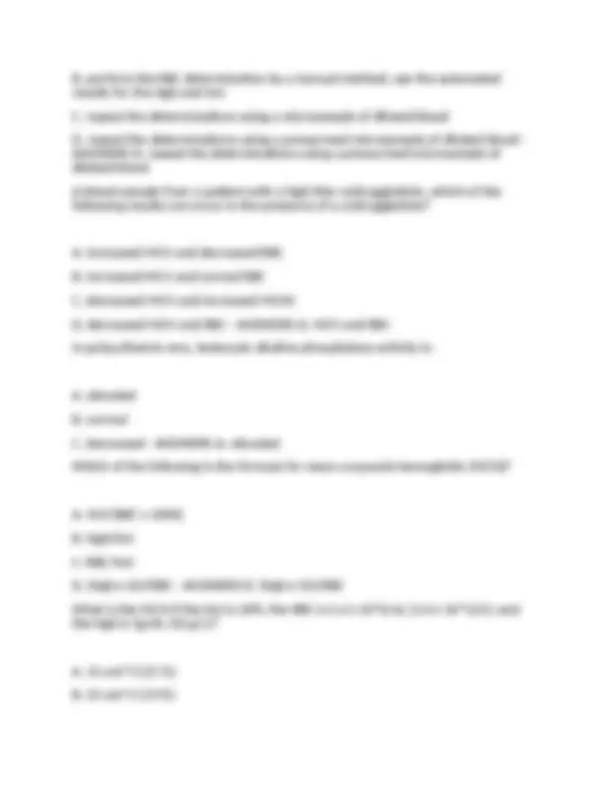
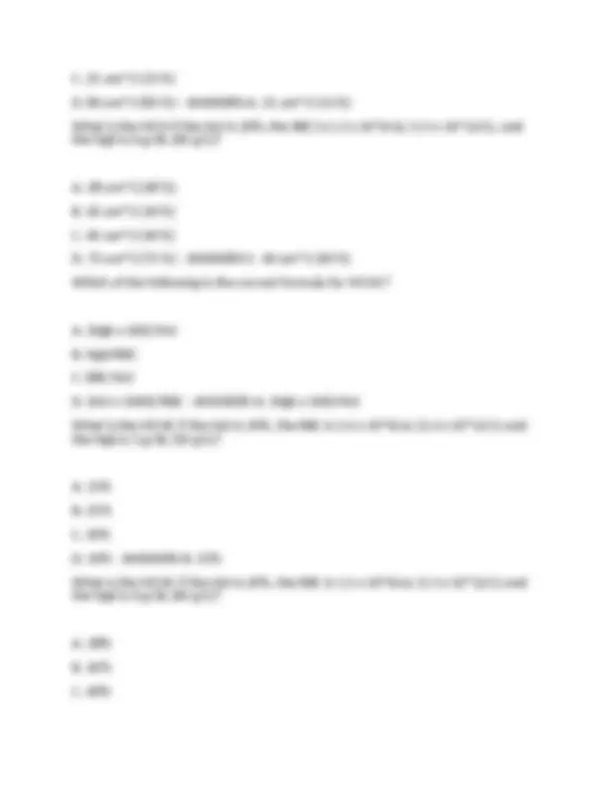


Study with the several resources on Docsity

Earn points by helping other students or get them with a premium plan


Prepare for your exams
Study with the several resources on Docsity

Earn points to download
Earn points by helping other students or get them with a premium plan
Community
Ask the community for help and clear up your study doubts
Discover the best universities in your country according to Docsity users
Free resources
Download our free guides on studying techniques, anxiety management strategies, and thesis advice from Docsity tutors
ASCP Hematology Review | 250 Questions | 100% Correct Answers 2025. ASCP Hematology Review | 250 Questions | 100% Correct Answers 2025.
Typology: Exams
1 / 17

This page cannot be seen from the preview
Don't miss anything!










The light-colored zone adjacent to the nucleus in a plasmacyte is the: A. ribosome B. chromatin C. mitochondria D. Golgi area - ANSWERS-D. Golgi area The majority of the iron in an adult is found as a constituent of: A. hemoglobin B. hemosiderin C. myoglobin D. transferrin - ANSWERS-A. hemoglobin The main function of the hexose monophosphate shunt in the erythrocyte is to: A. reglate the level of 2,3-DPG B. provide reduced glutathione to prevent oxidation of hemoglobin C. prevent the reduction of heme iron D. provide energy for membrane maintenance - ANSWERS-B. provide the level 2,3-DPG In order for hemoglobin to combine reversibly with oxygen, the iron must be: A. complexed with haptoglobin B. freely circulating in the cytoplasm C. attached to transferrin D. in the ferrous state - ANSWERS-D. in the ferrous state In which of the following disease states are teardrop cells and adnormal platelets
most characteristically seen? A. hemolytic anemia B. multiple myeloma C. G-6-PD deficiency D. myeloid metaplasma - ANSWERS-D. myeloid metaplasia In the normal adult, the spleen acts as a site for: A. storage of red blood cells B. production of red blood cells C. synthesis of erythropoietin D. removal of imperfect and aging cells - ANSWERS-D. removal of imperfect and aging cells After removal of red blood cells from the circulation hemoglobin is broken down into: A. iron, porphyrin, and amino acids B. iron, protoporphyrin, and globin C. heme, protoporphyrin, and amino acids D. heme, hemoseridin, and globin - ANSWERS-B. iron, protoporphyrin, and globin Heinz bodies are: A. readily identified with polychrome stains B. rarely found in glucose-6-phosphate dehydrogenase deficient erythrocytes C. closely associated with spherocytes D. denatured hemoglobin inclusions that are readily removed by the spleen - ANSWERS-D. denatured hemoglobin inclusions that are readily removed by the spleen Cells for the transport of O2 and CO2 are:
A. iron overload in tissue B. target cells C. basophilic stippling D. chronic blood loss - ANSWERS-D. chronic blood loss Evidence indicates that the generic defect in thalassemia usually results in? A. the production of abnormal globin class B. a quantitative deficiency in RNA resulting in decreased globin chain production C. a structured change in the heme portion of the hemoglobin D. an abnormality in the alpha- or beta-chain binding or affinity - ANSWERS-B. a quantitative deficiency in RNA resulting in decreased globin chain production An enzyme deficiency assciated with moderate to sever hemolytic anemia after the patient is exposed to certain drugs and characteristized by red cell inclusions formed by denatured hemoglobin is: A. lactate dehydrogenase deficiency B. G-6-PD deficiency C. pyruvate kinase deficiency D. hexokinase deficiency - ANSWERS-B. G-6-PD deficiency Patients with A(-) type G-6-PD deficiency are least likely to have hemolytic episodes in which of the following situations? A. following administration of oxidizing drugs B. following ingestion of fava beans C. during infections D. spontaneously - ANSWERS-D. spontaneously A patient has a congenital nonspherocytic hemolytic anemia. After exposure to anti-malarial drugs, the patient experiences a severe hemolytic episode. This episode is characterized by red cell inclusions caused by hemoglobin denaturation. Which of the following conditions is most consistent with these findings?
A. G-6-PD deficiency B. thalassemia major C. pyruvate kinase deficiency D. paroxysmal nocturnal hemoglobinuria - ANSWERS-A. G-6-PD deficiency Peripheral blood smears from patients with untreated pernicious anemia are characterized by: A. pancytopenia and macrocytosis B. leukocytosis and elliptocytosis C. leukocytosis and ovalocytosis D. pancytopenia and microcytosis - ANSWERS-A. pancytopenia and macrocytosis Laboratory tests performed on a patient indicate macrocytosis, anemia, leukopenia, and thrombocytopenia. Which of the following disorders is the patient most likely to have? A. anemia of chronic disorder B. vitamin B12 deficiency C. iron deficiency D. acute hemorrhage - ANSWERS-B. vitamin B12 deficiency The characteristic morphological feature in folic acid deficiency is: A. macrocytosis B. target cells C. basophilic stippling D. rouleax formation - ANSWERS-A. macrocytosis The most likely cause of the macrocytosis that often accompanies anemia of myelofibrosis is:
C. relative polycythemia associated with dehydration D. polycythemia associated with renal disease - ANSWERS-C. relative polycythemia associated with dehydration Which of the following is most likely to be seen in lead poisoning? A. iron overload in tissue B. codocytes C. basophilic stippling D. ringed sideroblasts - ANSWERS-C. basophilic stippling The characteristic morphologic feature in lead poisoning is: A. macrocytosis B. target cells (codocytes) C. basophilic stippling D. rouleax formation - ANSWERS-C. basophilic stippling Which of the following technical factors will cause a decreased erythrocyte sedimentation rate? A. gross hemolysis B. small fibrin clots in the sample C. increased room temperature D. tilting of the tube - ANSWERS-B. small fibrin clots in sample Which of the RBC indices is a measure of the amount of hemoglobin in individual red blood cells? A. MCHC B. MCV C. Hct
The RDW-CV and RDW-SD performed by automated cells counters are calculations that provide: A. an index of the distribution of RBC volumes B. a calculated mean RBC hemoglobin concentration C. a calculated mean cell hemoglobin D. the mean RBC volume - ANSWERS-A. an index of the distribution of RBC volumes The erythrocyte sedimentation rate (ESR) can be falsely elevated by: A. tilting the tube B. refrigerate blood C. air bubbles in the column D. specimen too old - ANSWERS-A. tilting the tube Which of the following is the formula for absolute cell count? A. number of cells counted/total count B. total count/number of cells counted C. 10 x total count D. % of cells counted x total cell count - ANSWERS-D. % of cells counted x total cell count The laboratory tests performed on a patient indicate macrocytosis, anemia , leukopenia, and thrombocytosis. Which of the following disorders is the patient most likely to have? A. iron deficiency B. hereditary spherocytosis C. vitamin B12 deficiency
Evidence of active red cell regeneration may be indicated on a blood smear by: A. basophilic stippling, nucleated red blood cells and polychromasia B. hypochromia, macrocytes, and nucleated red blood cellse C. hypochromia, basophilic stippling, and nucleated red blood cellse D. Howell-Jolly bodies, Cabot rings, and basophilic stippling - ANSWERS-A. basophilic stippling, nucleated red blood cells and polychromasia The presence of excessive rouleax formation on a blood smear is often accompanied by an increased: A. reticulocyte count B. sedimentation rate C. hematocrit D. erythrocyte count - ANSWERS-B. sedimentation rate The characteristic peripheral blood morphologic feature in multiple myeloma is: A. cytotoxic T cells B. rouleax formation C. spherocytes D. macrocytosis - ANSWERS-B. rouleax formation In polycythemia vera, the homeoglobin, hematocrit, red blood cell count, and red cell mass are: A. elevated B. normal C. decreased - ANSWERS-A. elevated The M:E ratio in polycythemia vera is usually:
A. normal B. high C. low D. variable - ANSWERS-A. normal Many microspherocytes, schostocytes, and budding off of spherocytes can be seen on peripheral blood smears of patients with: A. hereditary spherocytosis B. disseminated intrvascular coagulation (DIC) C. acquired automimmune hemolytic anemia D. extensive burns - ANSWERS-D. extensive burns Which of the following is most closely associated with erythroleukemia? A. ringed sideroblasts, nuclear budding, and Howell-Jolly bodies B. disseminated intravascular coagulation C. micromegakaryocytes D. lysozymuria - ANSWERS-A. ringed siderblasts, nulcear budding, and Howell-Jolly bodies The most characteristic peripheral blood smear finding in multiple myeloma is: A. plasmacytic satelitosis in the bone marrow B. many plasma cells in the peripheral blood C. many Mott cells in the peripheral blood D. rouleax formation of the red cells - ANSWERS-D. rouleax formation of the red cells A common source of interference in the cyanmethehemoglobin method is: A. hemolysis
D. increased hemoglobin - ANSWERS-D. increased emoglobin The laboratory findings on a patient are as follows: MCV: 55 um^3 (55 fL) MCHC: 25% MCH: 17 pg A stained blood film of this patient would most likely reveal a red cell picture that is: A. microcytic, hypochromic B. macrocytic, hypochromic C. normocytic, normochromic D. microcytic, normochromic - ANSWERS-A. microcytic, hypochromic A patient has the following laboratory results: RBC: 2.00 x 10^6/uL (2.00 x 10^12/L) Hct: 24% Hgb: 6.8 g/dL (68 g/L) Reticulocytes: 0.8% The mean corpuscular volume (MCV) of the patient is: A. 35 um^3 (35 fL) B. 83 um^3 (83 fL) C. 120 um^3 (120 fL) D. 150 um^3 (150 fL) - ANSWERS-C. 120 um^3 (120 fL) A patient has a high cold agglutinin titer. Automated cell counter results reveal an elevated MCV, MCH, MCHC. Individual erythrocytes appear normal on a stained smear, but agglutinates are noted. The appropriate course of action would be to: A. perform the RBC, Hgb, Hct determinations using manual methods
B. perform the RBC determination by a manual method; use the automated results for the Hgb and Hct C. repeat the determinations using a microsample of diluted blood D. repeat the determinations using a prewarmed microsample of diluted blood - ANSWERS-D. repeat the determinations using a prewarmed microsample of diluted blood A blood sample from a patient with a high titer cold agglutinin, which of the following results can occur in the presence of a cold agglutinin? A. increased MCV and decreased RBC B. increased MCV and normal RBC C. decreased MCV and increased MCHC D. decreased MCV and RBC - ANSWERS-D. MCV and RBC In polycythemia vera, leukocyte alkaline phosphatase activity is: A. elevated B. normal C. decreased - ANSWERS-A. elevated Which of the following is the formula for mean corpuscle hemoglobin (MCH)? A. Hct/(RBC x 1000) B. Hgb/Hct C. RBC/Hct D. (Hgb x 10)/RBC - ANSWERS-D. (Hgb x 10)/RBC What is the MCH if the Hct is 20%, the RBC is 2.4 x 10^6/uL (2.4 x 10^12/L) and the Hgb is 5g/dL (50 g/L)? A. 21 um^3 (21 fL) B. 23 um^3 (23 fL)
Which of the following is the correct formula for mean corpuscular volume (MCV)? A. (Hgb x 10)/RBC B. Hgb/Hct C. (Hct x 10)/RBC D. RBC/Hct - ANSWERS-C. (Hct x 10)/RBC Given the following data: Hgb: 8g/dL (80 g/L) Hct: 28% RBC: 3.6 x 10^6/uL (3.6 x 10^12/L) The MCV is: A. 28 um^3 (28 fL) B. 35 um^3 (35 fL) C. 40 um^3 (40 fL) D. 77 um^3 (77 fL) - ANSWERS-D. 77 um^3 (77fL) What is the MCV if the hematocrit is 20%, RBC is 2.4 x 10^6/uL and the hemoglobin is 5 g/dL? A. 68 pg B. 83 pg C. 100 pg D. 120 pg - ANSWERS-B. 83 pg What is the MCV if the hematocrit is 20%, RBC is 1.5 x 10^6/uL and the hemoglobin is 6 g/dL?
A. 68 pg B. 75 pg C. 115 pg D. 133 pg - ANSWERS-D. 133 pg The principle confirmatory test for hereditary spherocytosis is: A. osmotic fragility B. sucrose hemolysis C. heat stability test D. Kleihauer-Betke - ANSWERS-A. osmotic fragility A screening test for paroxysmal nocturnal hemoglobinuria is: A. heat instability test B. sucrose hemolysis C. osmotic fragility D. dithionite solubility - ANSWERS-B. sucrose hemolysis